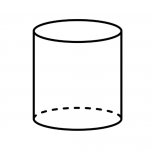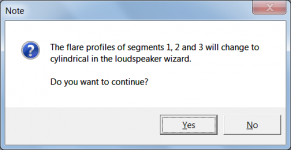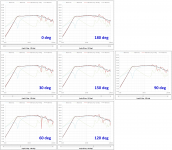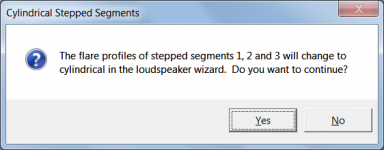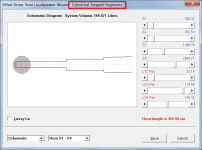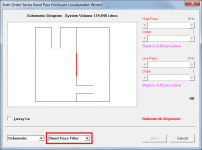Stepped segment are awesome. I don't manage to understand the problem as it is so much easy to switch off even for wizard.
Yes, but I still don't understand what you mean by "switch from round to square" 🙂.
That's because Ap1 refers to either a throat adaptor in the case of a normal horn, or a throat port in the case of an offset driver horn. It is not applicable to a standard bass reflex system, where Ap is used instead.
Am I to understand that Vrc, Lrc, Ap, Lpt, Ap1, Lp, S1-S5, and L12-L45 are all cylinder sections? If so, then sq cm and Par are throwing me off. Cylinder makes me think diameter instead of sq cm. Parabolic is not a cylinder profile.
Sections doesn't have any profile in sim on their own. But different profil have different expansion rate for the same section that allow to determine volumes at each distances. It's all about volumes and distances. Am i wrong ?
Hi BP1Fanatic,
When referring to the rear chamber in Post #10654, I said:
"The chamber is actually modelled in Hornesp as a cylinder of volume Vrc and length Lrc".
(I should have said "Hornresp" rather than "Hornesp", but that's beside the point... 🙂).
The rear chamber cylinder is closed at one end, with the driver diaphragm at the other end. The volume of air in the cylinder is given by Vrc, with the length of the cylinder Lrc being the axial distance from the driver diaphragm (assumed to be a rigid plane vibrating piston) to the closed end. The area in cm^2 of the circular cross-section of the cylinder can be calculated by dividing Vrc in cm^3 (Vrc in litres * 1000) by Lrc in cm.
Ap and Lpt define a vented rear chamber port tube (as used in a bass reflex system). The tube is cylindrical, with a cross-sectional area Ap and length Lpt.
Ap1 and Lp define a throat port in an offset driver horn system, or a throat adaptor in a normal horn system. A throat port is always cylindrical, whereas a throat adaptor can have a cylindrical, conical, exponential or parabolic profile. The reasons why the two are different, are given in Post #10677.
S1 to S5 are the circular cross-sectional areas at the throats and mouths of the four possible segments. L12 to L45 are the axial lengths of those segments. The each segment can have a different flare profile.
A cylinder is a three-dimensional shape, as shown in the attachment. It is round and has a top and bottom in the shape of a circle. The top and bottom are flat and always the same size. A cylinder can be described using length, area and volume parameters.
The Hornresp simulation models assume that all ports and segments are axisymmetric - that is, that they are symmetrical relative to the axis, and have circular cross-sections.
Hope this helps to clarify things.
Stay safe,
David
Am I to understand that Vrc, Lrc, Ap, Lpt, Ap1, Lp, S1-S5, and L12-L45 are all cylinder sections?
When referring to the rear chamber in Post #10654, I said:
"The chamber is actually modelled in Hornesp as a cylinder of volume Vrc and length Lrc".
(I should have said "Hornresp" rather than "Hornesp", but that's beside the point... 🙂).
The rear chamber cylinder is closed at one end, with the driver diaphragm at the other end. The volume of air in the cylinder is given by Vrc, with the length of the cylinder Lrc being the axial distance from the driver diaphragm (assumed to be a rigid plane vibrating piston) to the closed end. The area in cm^2 of the circular cross-section of the cylinder can be calculated by dividing Vrc in cm^3 (Vrc in litres * 1000) by Lrc in cm.
Ap and Lpt define a vented rear chamber port tube (as used in a bass reflex system). The tube is cylindrical, with a cross-sectional area Ap and length Lpt.
Ap1 and Lp define a throat port in an offset driver horn system, or a throat adaptor in a normal horn system. A throat port is always cylindrical, whereas a throat adaptor can have a cylindrical, conical, exponential or parabolic profile. The reasons why the two are different, are given in Post #10677.
S1 to S5 are the circular cross-sectional areas at the throats and mouths of the four possible segments. L12 to L45 are the axial lengths of those segments. The each segment can have a different flare profile.
Cylinder makes me think diameter instead of sq cm.
A cylinder is a three-dimensional shape, as shown in the attachment. It is round and has a top and bottom in the shape of a circle. The top and bottom are flat and always the same size. A cylinder can be described using length, area and volume parameters.
The Hornresp simulation models assume that all ports and segments are axisymmetric - that is, that they are symmetrical relative to the axis, and have circular cross-sections.
Hope this helps to clarify things.
Stay safe,
David
Attachments
It's all about volumes and distances.
For flared horn segments, it's more about areas and distances 🙂.
If the reason for not simulating stepped segments is the number of sliders, you can disable the area sliders if the simulation is stepped.
Simply disabling the sliders wouldn't help - it is the code controlling how the slider values are interpreted (even when disabled), that would need to change.
Stepped segment are awesome. I don't manage to understand the problem as it is so much easy to switch off even for wizard.
Stepped segments are indeed an excellent part of the program and sometimes allow a more accurate portrayal of an easier build architecture in steps that can be placed at folds in a line instead off folding up an assumed constant smooth taper throughout the length of a TL. Merely measuring width at the beginning and end of a segment(folded section) to verify accurate instead of spreading a taper out evenly through multiple turns and possibilities. If lucky you can even drop the driver offset at the first turn.
Instead of nickel and diming a design through folds and turns trying to create the taper or flare entered in the sim. It can simply be segments of the same CSA throat to mouth for each L12,23,34.... in a grouped taper or flare.
I don’t know if that helps anyone but it’s applicable in everything from pvc pipe sections and couplers to a wooden box full of rectangles. So far so good in a half dozen or so using this approach?
Stepped segments are indeed an excellent part of the program
Hi Booger weldz,
I am sure that Mårten would agree with you that the stepped segment functionality can be very useful. His key concern I think, is that what is specified on the main input parameters window can sometimes change in the loudspeaker wizard (depending on what was originally specified), so that the system simulated in the wizard becomes different to the one the user intended. My view is that even though this can happen, it is still beneficial to retain the feature so that absorbent filling material can be added to those stepped designs that do not change.
It is really just a question of the user understanding the limitations of the tool...
Stay safe,
David
Hi Booger weldz,
I am sure that Mårten would agree with you that the stepped segment functionality can be very useful. His key concern I think, is that what is specified on the main input parameters window can sometimes change in the loudspeaker wizard (depending on what was originally specified), so that the system simulated in the wizard becomes different to the one the user intended. My view is that even though this can happen, it is still beneficial to retain the feature so that absorbent filling material can be added to those stepped designs that do not change.
It is really just a question of the user understanding the limitations of the tool...
Stay safe,
David
It’s bit me a couple times before I realized what was happening in and out of ‘wizard’. But knowing that ahead of time, there is no major upsets in things and /or problem and if that’s a slight necessary evil to an otherwise priceless feature than I say well done(once again). Btw, the recent offset port feature in OD ‘closed’ is another brilliant addition that allows a great many opportunities to explore cancelation/supportive standing waves from two closed ends and the associated length/area creating a fundamental and harmonics off each. 🙏 exciting stuff David!
It’s bit me a couple times before I realized what was happening in and out of ‘wizard’.
Hi Booger weldz,
In an attempt to reduce the potential for confusion, in the next update Hornresp will check the input parameters window stepped segment design before the loudspeaker wizard opens, and display a context-sensitive warning message when required. Hopefully this will also go some way towards allaying Mårten's concerns. An example of one of the proposed messages is shown in the attachment.
Stay safe,
David
Attachments
Hi Booger weldz,
In an attempt to reduce the potential for confusion, in the next update Hornresp will check the input parameters window stepped segment design before the loudspeaker wizard opens, and display a context-sensitive warning message when required. Hopefully this will also go some way towards allaying Mårten's concerns. An example of one of the proposed messages is shown in the attachment.
Stay safe,
David
You’re generous efforts and contributions to this are inspiring. This hobby/science/art/craft/occupation of building speakers would never be so popular in so many places with so many people if not for you. I hope you sleep well at night knowing how important that really is and how successfully you’ve impacted it. More recently than ever, people are using this software to create things that free their minds from the strange events taking place around them. You bring people a moment for calm and creative in a time of anxious and awkward.
Thanks David🙂
Hi BP1Fanatic,
When referring to the rear chamber in Post #10654, I said:
"The chamber is actually modelled in Hornesp as a cylinder of volume Vrc and length Lrc".
(I should have said "Hornresp" rather than "Hornesp", but that's beside the point... 🙂).
The rear chamber cylinder is closed at one end, with the driver diaphragm at the other end. The volume of air in the cylinder is given by Vrc, with the length of the cylinder Lrc being the axial distance from the driver diaphragm (assumed to be a rigid plane vibrating piston) to the closed end. The area in cm^2 of the circular cross-section of the cylinder can be calculated by dividing Vrc in cm^3 (Vrc in litres * 1000) by Lrc in cm.
Ap and Lpt define a vented rear chamber port tube (as used in a bass reflex system). The tube is cylindrical, with a cross-sectional area Ap and length Lpt.
Ap1 and Lp define a throat port in an offset driver horn system, or a throat adaptor in a normal horn system. A throat port is always cylindrical, whereas a throat adaptor can have a cylindrical, conical, exponential or parabolic profile. The reasons why the two are different, are given in Post #10677.
S1 to S5 are the circular cross-sectional areas at the throats and mouths of the four possible segments. L12 to L45 are the axial lengths of those segments. The each segment can have a different flare profile.
A cylinder is a three-dimensional shape, as shown in the attachment. It is round and has a top and bottom in the shape of a circle. The top and bottom are flat and always the same size. A cylinder can be described using length, area and volume parameters.
The Hornresp simulation models assume that all ports and segments are axisymmetric - that is, that they are symmetrical relative to the axis, and have circular cross-sections.
Hope this helps to clarify things.
Stay safe,
David
Understood. Think musical instruments instead of BOX enclosures, hence HORN response!
You too guy!
You’re generous efforts and contributions to this are inspiring. This hobby/science/art/craft/occupation of building speakers would never be so popular in so many places with so many people if not for you. I hope you sleep well at night knowing how important that really is and how successfully you’ve impacted it. More recently than ever, people are using this software to create things that free their minds from the strange events taking place around them. You bring people a moment for calm and creative in a time of anxious and awkward.
Thanks David🙂
+1!
Thanks David🙂
Thanks Booger weldz.
Your kind comments in these difficult times mean a great deal to me. Take care and stay safe.
David
You’re generous efforts and contributions to this are inspiring. This hobby/science/art/craft/occupation of building speakers would never be so popular in so many places with so many people if not for you. I hope you sleep well at night knowing how important that really is and how successfully you’ve impacted it. More recently than ever, people are using this software to create things that free their minds from the strange events taking place around them. You bring people a moment for calm and creative in a time of anxious and awkward.
Thanks David🙂
Right on spot.
Thanks David for you efforts!
Mårten
Your comment reminded me I completely forgot to post a follow-up to your MTLT question concerning pressure response at various directions if woofer and port were spaced half a wavelength at 400Hz. I used Hornresp inputs you provided on your website here: The Subwoofer DIY Page v1.1 - Projects : The Boom UnitHi David, can you include the value for "Path" be included in the BOXPLAN export option in your next update for Hornresp? I'm looking at how the value for "Path" can impact the power response of MLTL designs, and it looks like the impact can be pretty noticeable in some cases.
If you rearranged the geometry of your "Boom Unit" to place the port 43cm behind the woofer (ie worst case), you would see variations in response above 200Hz as you walked around the enclosure.
Posts related to this topic:
Post#10455 - 10456
Post#10467
Post#10479
Attachments
Hornresp Update 5070-200429
Hi Everyone,
CHANGE 1
The acoustic path length parameter value in the Loudspeaker Wizard now changes when a new path value is imported from BOXPLAN. Previously the original path value exported from BOXPLAN continued to be used, rather than being replaced by the updated value.
CHANGE 2
Hornresp now checks stepped segment designs before the loudspeaker wizard opens, and when required, displays a context-sensitive warning message as shown in the Attachment 1 example.
CHANGE 3
A number of minor operating anomalies in different parts of the user interface have now been fixed (they were not affecting the accuracy of the simulation results).
Stay safe,
David
Hi Everyone,
CHANGE 1
The acoustic path length parameter value in the Loudspeaker Wizard now changes when a new path value is imported from BOXPLAN. Previously the original path value exported from BOXPLAN continued to be used, rather than being replaced by the updated value.
CHANGE 2
Hornresp now checks stepped segment designs before the loudspeaker wizard opens, and when required, displays a context-sensitive warning message as shown in the Attachment 1 example.
CHANGE 3
A number of minor operating anomalies in different parts of the user interface have now been fixed (they were not affecting the accuracy of the simulation results).
Stay safe,
David
Attachments
This has probably been asked before, but this topic is just to huge and the search wasn't really helpful:
So I simulated a bandpass and finally got in nailed down to something I'd like. Now however I seem to stuck with the wizard. How can I now do a MaxSPL or start a Filter Wizard?
So I simulated a bandpass and finally got in nailed down to something I'd like. Now however I seem to stuck with the wizard. How can I now do a MaxSPL or start a Filter Wizard?
How can I now do a MaxSPL or start a Filter Wizard?
Hi 4real,
The maximum SPL option is not available with band pass loudspeaker systems. The BP wizard was added as something of an afterthought at the request of users, and the features provided are relatively limited. It does have an inbuilt active band pass filter though.
Stay safe,
David
Attachments
- Home
- Loudspeakers
- Subwoofers
- Hornresp
